Every Wisconsin voter has a right to cast a ballot privately and independently at their polling place on Election Day. In addition, the Help America Vote Act (HAVA) requires that every polling place in the State of Wisconsin meet Americans with Disabilities Act (ADA) accessibility standards. Local election officials have a responsibility to guarantee that each of their polling places meets these standards and that all voters are provided with an equal opportunity to cast a ballot.
Polling places should be organized so that all voters can be processed efficiently and voters with disabilities can navigate the voting area and participate in the electoral process without assistance. The Polling Place Accessibility Toolkit provides an overview of the accessibility standards that every polling place must meet.
It is important to note that polling place accessibility begins in the parking area and applies to any pathway or obstacle that a voter with a disability would have to navigate to gain access to the voting area. The voting area should be configured to allow passage throughout the space for a voter in a wheelchair and accessible voting booths and machines should both meet ADA standards and be positioned to ensure voter privacy.
Municipal clerks should use this guide to train their election inspectors before an election cycle on the guidelines for proper polling place organization. If an accessibility-related problem is identified on Election Day, the Quick Fix Guide can be used to create a sufficient temporary solution until the issue can be resolved permanently.
The WEC conducts audits of polling places around the state for each election and works with municipalities to correct identified problems and improve accessibility. The results of those audits are reported to each municipality and a Plan of Action is required from the municipal clerk to address any concerns found during the audit. Municipal clerks are then able to request accessibility-related supplies from the WEC to assist them with bringing their polling places into compliance.
The information gathered during polling place audits is analyzed and used to improve and update clerk and poll worker training materials and voter outreach information. This data is also used to inform the Wisconsin State Legislature about the barriers that citizens with disabilities face when voting.
Polling Place Accessibility Forms
Accessibility Training Webinars
WEC and accessibility partners have worked together to offer trainings for clerks and poll workers. Those trainings are available on ElectEd, or on the WEC Vimeo Channel.
Choosing a New Polling Place
When you're deciding on a new polling place, there are some accessibility considerations to keep in mind.
Curbside Voting
If a voter cannot enter the absentee voting location or polling place due to disability, Wis. Stat. § 6.82(1) requires that curbside voting must be available. Two poll workers should bring a ballot to the individual needing assistance, and conduct voting at their vehicle, or at the polling place entrance. These voters are not required to sign the poll list. Instead, the poll workers should write “exempt by order of inspectors” in the signature space on the poll list. This incident should also be recorded on the Inspector’s Statement (EL-104).
If curbside voters need to update their registration due to an address or name change or if they are not currently a registered voter, they may also register to vote curbside with a current and valid Proof of Residence. Curbside voting should also be available during the in-person absentee voting period. Persons who would like to vote curbside should be encouraged to contact their municipal clerk beforehand to discuss how to initiate the process upon arrival at the voting location.
Accommodations
Wisconsin law requires the municipal clerk to make reasonable accommodations for voters with disabilities.
Specifically, Wisconsin Statutes permit an individual with a disability to notify a municipal clerk that or she intends to vote at a polling place on election day and to request a specific type of accommodation that will facilitate his or her voting. (View s. 5.36, Stats.)
When such a request is received, Wisconsin Statutes require the municipal clerk to make reasonable efforts to comply with requests for voting accommodations made by individuals with disabilities whenever feasible. (View s. 7.15 (14), Stats.)
10 Common Accessibility Problems and How to Solve Them
Current Wisconsin law requires notices, instructions, sample ballots and ward maps to be posted in each polling place. The Americans with Disabilities Act (ADA) requires that all of these postings be printed in at least 18-point type so that voters with vision impairments will have increased access to these resources.
All of the required notices and instructions are posted on the WEC website in the required type size and can be downloaded and printed for polling place use. In addition, two sample copies of each ballot type should be posted in the voting area. Ward maps and street directories clearly indicating all the wards in the municipality served by that polling place must also be prominently displayed.
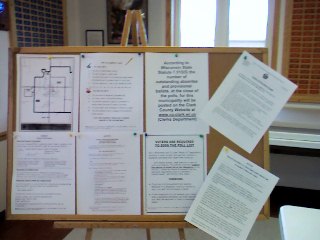

Please note that certain notices, such as the Type D Notice, need to be customized for each election and some forms, such as the EL-112 Notice of Crossover Voting at a Partisan Primary, are only applicable to certain elections.
For sample election notices click here
For polling place notices click here.
A full list of the required postings can be found on pages 27 and 28 of the Election Day Manual with a polling place checklist available on page 31.
Accessible Parking Requirements
All facilities that serve as polling places must have accessible parking available on Election Day. For facilities with off-street parking (i.e. parking lots/areas) there must be at least one Van-Accessible parking space available and the number of required additional accessible parking spaces is determined by the total number of parking spaces in the parking area.
| Total Parking Spaces | Required Accessible Spaces |
|---|---|
| 1 - 25 | 1 |
| 26 - 50 | 2 |
| 51 - 75 | 3 |
| 76 - 100 | 4 |
| 101 - 150 | 5 |
| 151 - 200 | 6 |
Van-Accessible Parking
A Van-Accessible parking space should at least 8 feet wide with an adjacent accessible aisle that is also at least 8 feet wide. Regular accessible spaces should also be 8 feet wide, but need only 5 foot wide accessible aisles. Accessible spaces that meet standards for Universal Design should be 11 feet wide with 5 foot wide accessible aisles.
Each accessible space should be marked with a sign bearing the universal symbol of accessibility that is posted between 60” and 80” above the ground. All Van-Accessible spaces should have additional signage indicating that it is available for van parking. Parking areas where all accessible spaces meet Universal Design standards are exempt from the additional signage requirement for Van-Accessible parking spaces.
All accessible parking spaces are required to be located on level, firm and slip-resistant ground such as asphalt or concrete.
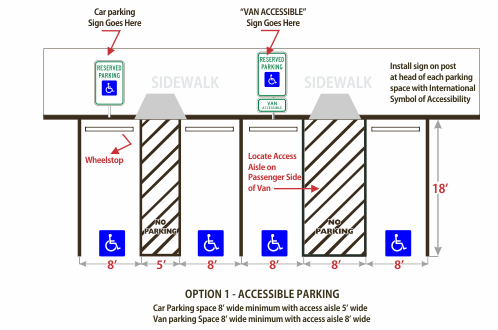

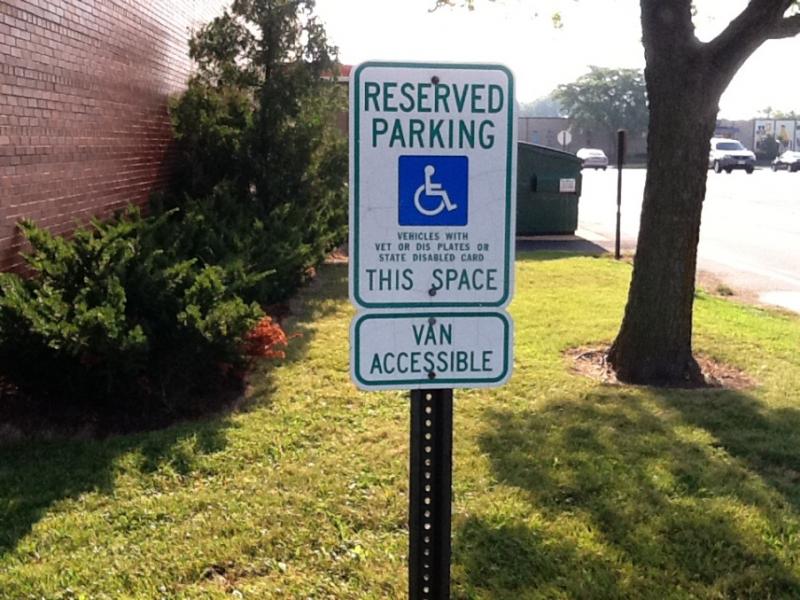
Best Practices
The images below are examples of off-street parking areas with good accessible parking layouts. These locations have multiple spaces that meet the size requirements with proper signage posted. These parking areas are paved with asphalt and the spaces are located closest to the accessible entrance allowing a voter with a disability to travel the shortest distance from the parking area to the entrance.
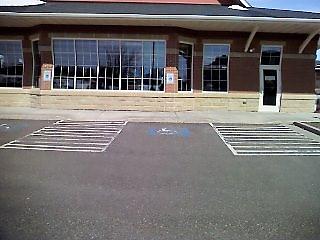

Note that one accessible aisle can be used to create two accessible spaces by locating an accessible space on either side of the aisle. Please see the accessible parking space diagrams provided above for examples of this type of layout.
The below pictured facility is a good example of proper accessible parking for locations with only on-street parking. There is one properly-signed space available that is located adjacent to the accessible pathway leading to the entrance. Notice that a cub cut is provided to ensure access from the street to the pathway.
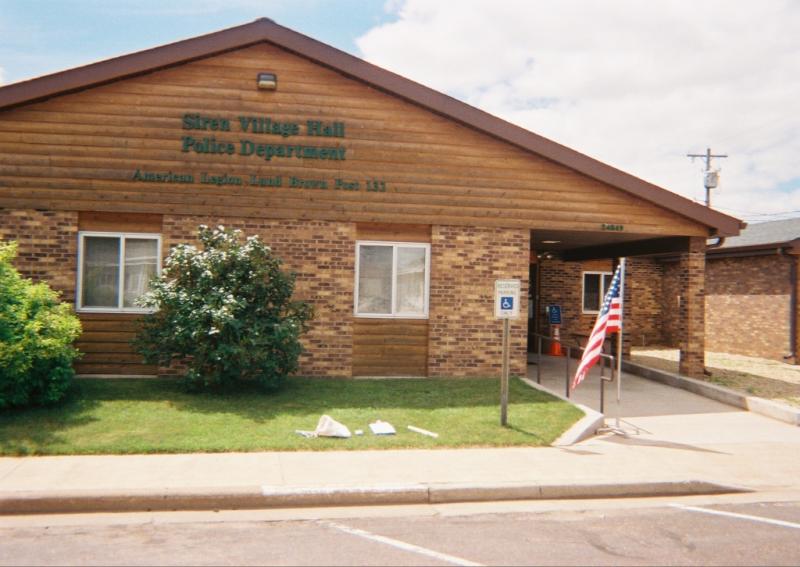
Common Problems
Many voting locations do not have spaces reserved for voters with disabilities in the parking area. The facility shown below has no marked accessible parking spaces located closest to the accessible entrance.
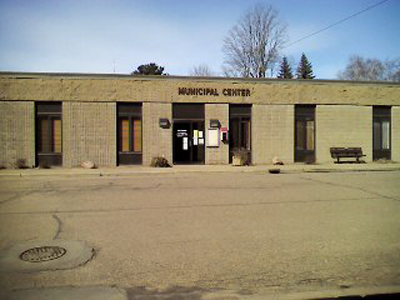
Many parking areas have accessible spaces that are only marked on the ground. The ADA requires that all accessible parking spaces have signs posted between 60” and 80” above the ground. Accessible parking spaces without signs posted above ground and accessible parking signs that are not posted at the required height can become obscured by a vehicle parked in the spot or by snow during the winter months.
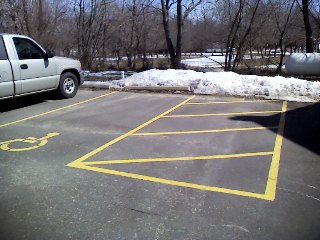
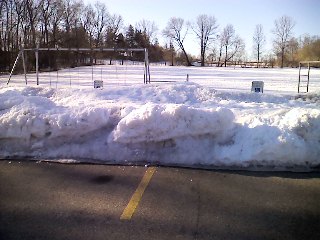
Signage should always be mounted to a post or pole or affixed to the side of a building. It should never be placed leaning up against the side of a building and should be replaced if damaged or uprooted.
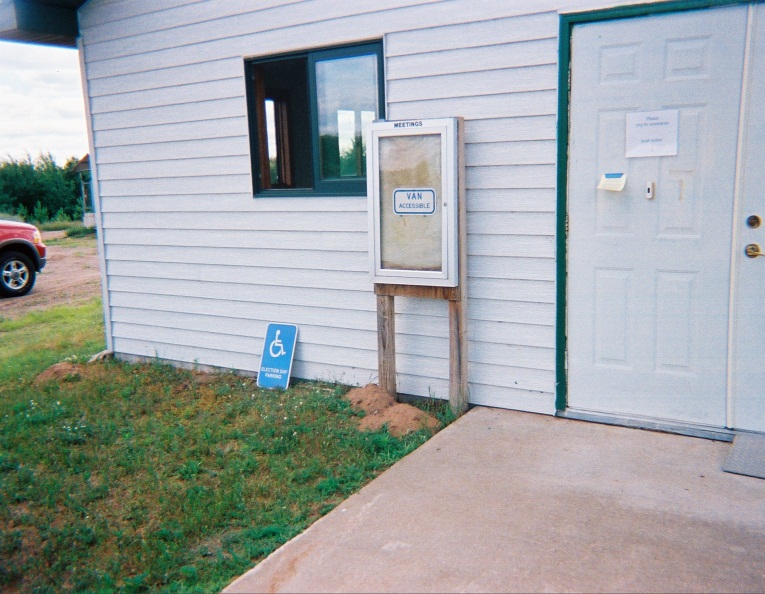
The accessible entrance of the polling place must be marked with the universal symbol of accessibility. This allows voters with mobility issues to easily identify the accessible entrance. It also lessens the possibility that a voter with a disability will enter a facility at an entry point that does not afford them access to the voting area or to an elevator or wheelchair lift that they would need to use to travel to the voting area.
Best Practices
Accessible entrances can be identified using a window decal or sign like the examples found below. If a municipality does not own the facility where a polling place is located, a reusable or temporary sign can be displayed for Election Day.
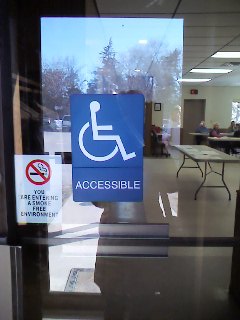
Common Problems
Entrances that are not properly identified can be problematic for voters, especially at facilities that have multiple entrances and voting areas that are not located directly inside of the accessible entrance. The below photos depict doors that are not properly marked as the accessible entrance and an unmarked entrance that, upon entry, requires a voter to navigate stairs.
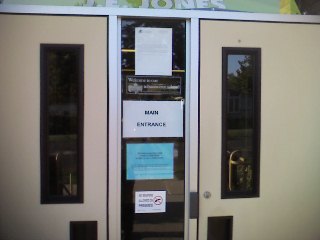

All doors at accessible entrances must be able to be opened with a closed fist using 8 pounds of force or less. In addition, all doors along the interior route of a polling place from the accessible entrance to the voting area need to meet the same standard. Meeting this standard allows all voters to gain access to the facility and voting area without assistance.
Best Practices
All doors at the accessible entrance and along the interior route should be tested to see if they meet ADA standards. This can be done using a door pressure gauge. Doors that require too much pressure to open should be adjusted accordingly.
Any interior doors along the interior route to the voting area should be propped open on Election Day to remove a potential barrier for accessing the voting area.
Heavy exterior doors can be fixed by installing an electronic accessible feature such as an automatic opener or doorbell to assist voters. A greeter can also be stationed by the accessible entrance to ensure that all voters have access to the facility.
The accessible pathway is the route that a voter would have to travel from the accessible parking space(s) to the accessible entrance. WEC accessibility auditors only audit the accessible pathway and do not review all pathways at a visited facility. The pathway should be at least 36” wide and should not have any objects on or next to the pathway (e.g. flags, banners, tree branches, etc.) that would cause that pathway to narrow to less than 32” for a short period of time. The pathway should be on a firm, stable and slip-resistant surface such as asphalt or concrete and not have any breaks or edges where the height difference is over ½ inch.
Best Practices
The two facilities pictured below both have accessible pathways that meet ADA standards. Both pathways are wider than the required 36” and are made of concrete. In addition, the below facility has an accessible pathway that is level with the parking area and does not require a visitor to the facility to navigate a curb cut or pathway ramp to reach the accessible entrance. Both pathways also do not have any objects on or above the pathway that would create an impediment for a voter.

Common Problems
Accessible pathways with large breaks or cracks in them create hazards for voters who use canes, walkers or wheelchairs. Pathways that have segments with a height difference of over ½ inch also represent a tripping hazard for all voters, especially those with mobility issues. These height differences can be caused by tree roots growing under the pathway or by damage from snow and ice during winter.
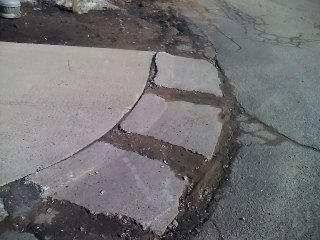

All breaks and cracks over ½ inch in size should be filled in or repaired. Pathways with significant height differences can be shaved or ground down to fix the problem. If there is extensive damage to an accessible pathway, the only remedy may be to replace the pathway or relocate that accessible parking area to a location where an acceptable pathway can be used to provide access to the accessible entrance of the facility.
State law requires that a table or booth be available for voters with disabilities who wish to cast a paper ballot and who do not wish to use the accessible voting system. This booth or table should meet all ADA requirements for height, width and toe/knee clearance. The booth or table also should be clearly visible when voters enter the voting area and be positioned or set up to ensure voter privacy.
The entrance to the table should be at least 30” wide and the height from the floor to the underside of the table must be a minimum of 27”. The top of the table or writing surface must be no higher than 34” and there should be at least 19” of knee/toe clearance under the table so that a voter in a wheelchair will have access to the top of the booth or table/writing surface. Please note that the table in the above diagram is pictured with an accessible voting machine on top of it, but the same standards apply to the booth or table where a voter with a disability can cast a paper ballot.

Best Practices
Pictured below are two common practices for providing an accessible booth or table for a voter with a disability who wishes to cast a paper ballot. In the below photo, a folding table that meets ADA standards has been set up with privacy shields on top to ensure voter privacy.
Many municipalities use ADA-compliant voting booths like the one shown in the below right image. These booths are similar to regular voting booths, but are lower to the ground and have a wider entrance to provide access for voters in wheelchairs. The accessible voting booths also afford the same degree of privacy as regular voting booths.
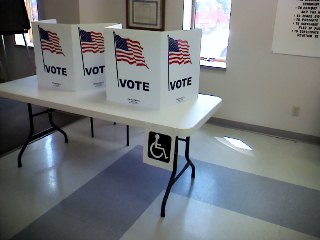

Common Problems
Both of the tables pictured below do not provide privacy for voters using them to cast a paper ballot. The table pictured in the below does have a magnifying glass to assist voters with vision problems, but lacks a privacy shield. In addition, those materials are placed on the table in a location that would not provide the full 19” of knee/toe clearance due to the presence of the table legs and support bars.
The booth or table where a voter with a disability can cast a paper ballot should also be visible to all voters when they enter the voting area. This may be a challenge at facilities with smaller voting areas. ADA-compliant tables should not be located in bathrooms, kitchen areas or in a location that is out of plain sight from the voters.
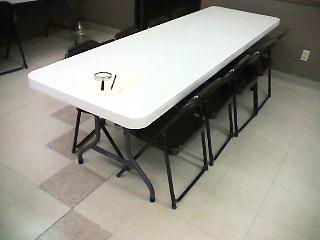
Interior routes are any hallway or corridor that a voter would have to travel from the accessible entrance to the voting area. These areas should be well lit on Election Day and free from obstacles that could pose a hazard for voters with vision problems or voters who use a wheelchair or walker.
Common obstacles that can be relocated for Election Day include folding tables, trash cans and chairs. Permanent fixtures, such as drinking fountains and display cases, should be marked with a cane-detectable barrier or object such as a traffic cone.
All hallways and corridors must also be 48” wide and cannot narrow for more than a short distance to less than 36” wide.
If the voting area is not directly inside the accessible entrance, signage directing voters to the voting area must be provided. This practice allows voters with mobility issues to travel the most direct route to the voting area.
Best Practices
All interior routes from the accessible entrance to the voting area should be marked with large print signs directing voters to the voting area. The sign pictured in the below photo allows voters to identify the voting area without confusion. In another photo below, directional signs are used to direct voters to the elevator that they would need to use to access the voting area.
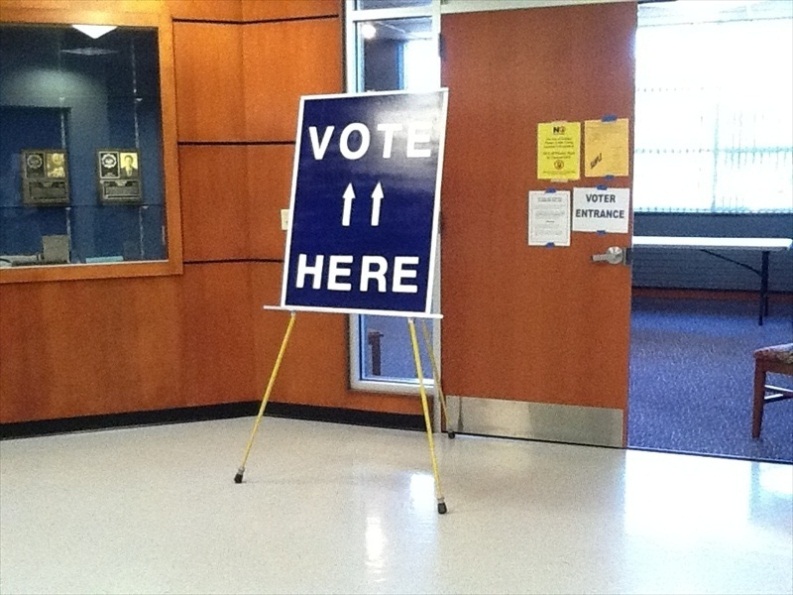
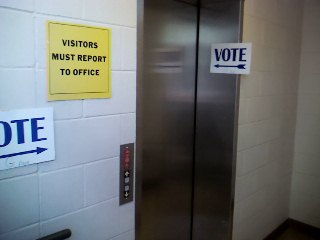
The below photo illustrates the proper method for marking a permanent or semi-permanent obstacle along the route to the voting area. The traffic cone allows voters with visual impairments who use a cane to detect the obstacle and move around it.
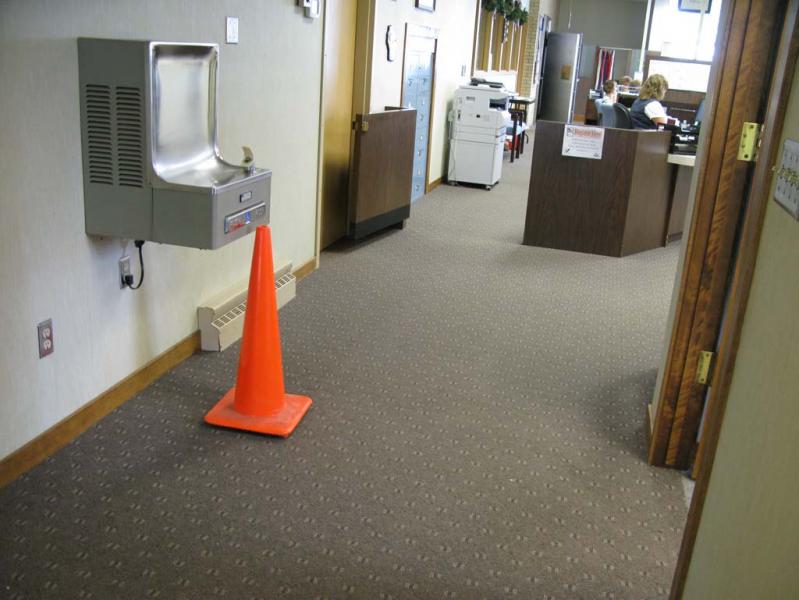
Common Problems
Pictured below are examples of obstacles that should either be removed or marked with a cane-detectable barrier on Election Day. The below photos illustrate that objects such as recycling bins and trash cans should be removed from corridors and hallways that voters will use to access the voting area. In another example, a table that restricts access to the voting area and a drinking fountain that should be marked with a cane-detectable barrier, but is not. These barriers can be eliminated during a quick walk thorough by the municipal clerk, or another election worker, on or before Election Day.

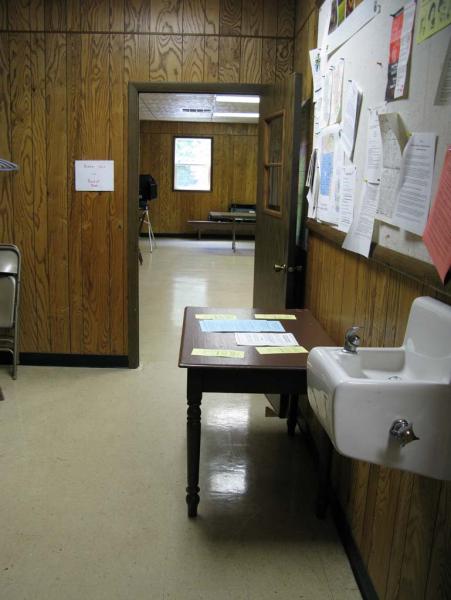
The below photos represent situations where the set-up of a polling place has inadvertently created accessibility issues. The use of traffic cones in the below photo was an attempt to create orderly flow of voters in and out of the voting area, but instead created a corridor that would not allow a voter in a wheelchair to enter the voting area without moving the cones. In the below photo, the tables that have been set up in the hallway create a congested path of travel that narrows for a significant distance. These situations also illustrate how polling place set-up for efficient voter flow interacts with accessibility standards.
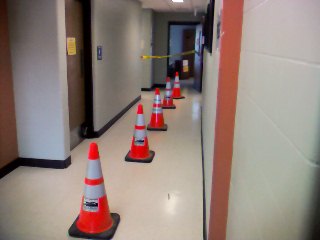

Federal and state law requires an accessible voting system to be present at each polling place for every election. The machine/system should be tested before each election to ensure that it is functioning properly. The machine/system should be set up in a clearly visible location in the voting area, so that voters will know that it is available for use. If the machine/system is not functioning properly on Election Day, election workers should be sure to contact their municipal clerk immediately and work with their county or vendor to remedy the problem.
Accessible voting equipment should be set up on a table or stand that meets ADA guidelines. The entrance to this table or stand should be at least 30” wide and the height from the floor to the underside of the table or stand must be a minimum of 27”. There should also be at least 19” of knee/toe clearance under the table so that a voter in a wheelchair will have access to the machine.
In addition, there should also be at least 30 x 48” of clear floor space in front of the table or stand holding the accessible voting equipment. The height of the controls for the machine or the touch screen must be no higher than 54” for a parallel approach or 48” for a forward approach.
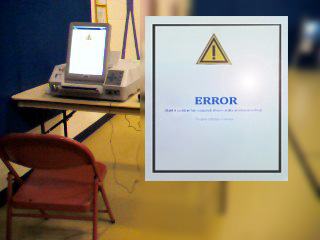
Accessible voting machines should also be positioned to ensure voter privacy. The machine pictured in the below photo has a privacy hood attached to it but is set up in a way where others could see how a voter who is using the machine was marking their ballot.


Common Problems
The accessible voting machine should always be set up, turned on and functioning properly on Election Day. Voters who wish to use the machine should not have to wait for an election official to set-up, plug in or insert an ink cartridge or memory device into the machine. Error messages like the one pictured below indicate that the accessible voting machine requires troubleshooting or service from a technician.

The accessible voting machine should also be visible to all voters when they enter the voting area. This may be a challenge at facilities with smaller voting areas. The machines should not be located in separate rooms such as bathrooms or kitchen areas or in a location that is out of plain sight from voters, like the machine pictured in the below right photo located in the corner of a storage area behind a filing cabinet.
All polling place doors that a voter with a disability would have to open must have hardware, such as a lever or bar, which is usable with one hand without tight grasping, pinching or twisting of the wrist. A municipality can also choose to install an electronic accessible feature, such as an automatic opener or wireless doorbell, to ensure that voters can access the facility and voting area without assistance.

Best Practices
Accessible door hardware or an electronic accessible feature should be present on all doors from the accessible entrance to any doors on the path of travel from that entrance to the voting area. Doors along the interior route to the voting area can be propped open on Election Day. This practice would eliminate the need for accessible door hardware or an electronic accessible feature.
The door hardware pictured below meet the standards for accessibility. Both types of hardware are usable with one hand without having to grab and twist the hardware to open the door.
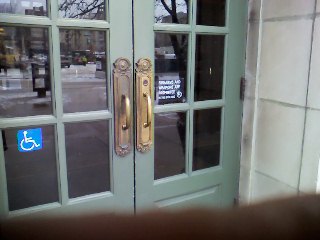

These two photos show two different electronic accessible features with the entrance on the left utilizing a wireless doorbell or buzzer and the door on the right having an automatic opener present.
If no accessible hardware or electronic feature is present, a greeter can be stationed at the door to ensure that voters who require assistance can gain entrance to the polling place and voting area.
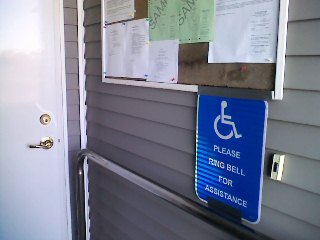

Common Problems
The door hardware picture below does not meet accessibility standards. The doorknob in the below left photo requires a grasping and twisting motion to use and the hardware on the right cannot be opened with one hand without tight grasping. Inaccessible hardware should be replaced or an electronic accessible feature could be installed to fix the problem. If these changes are not possible, a greeter can be stationed at the door to assist voters with entering the polling place.

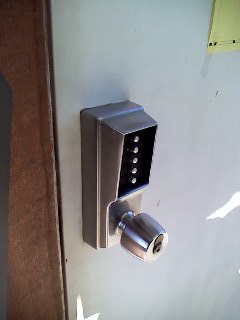
The pathway from the accessible parking area/spaces to the accessible entrance should be marked with signs clearly directing voters to the correct entrance. This practice is especially important at facilities where the accessible entrance is not the same as the main entrance. Voters with mobility issues should not be burdened by entering the polling place at a point that does not provide them barrier-free access to the voting area (i.e. there should be no stairs or inaccessible doors along the route). Voters with disabilities should also not have to search for the correct entrance to a polling place.
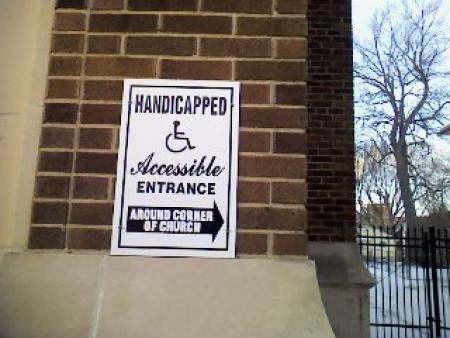
Best Practices
Both of the facilities pictured below have entrance ramps that provide access to the facility with signage posted directing voters to the accessible entrance. These signs are posted high enough to be clearly visible from the parking area.
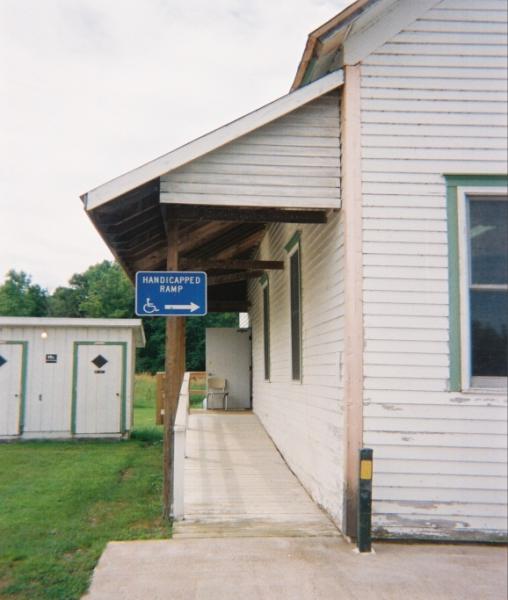
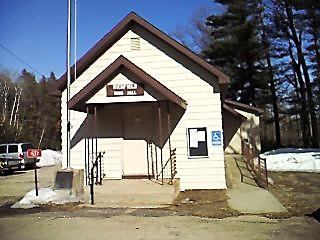
In the below left photo, the accessible entrance is identified by a sign posted in the accessible parking area, providing voters with clear entrance information in a visible location. The facility pictured on the bottom right has a sign present at the base of the stairs providing information on the location of the accessible entrance.


Learn About Accessibility Audits
Auditors from the Wisconsin Elections Commission conduct site visits at polling places around the state on Election Day to review the accessibility to voters.